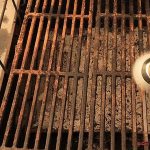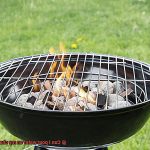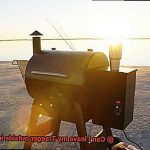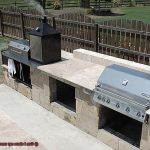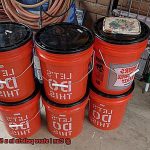Hey there, barbecue aficionados. Are you ready to elevate your smoking game and create some mouth-watering ribs? If you’re like most grill masters, you probably know that ribs are one of the most popular meats to smoke. But here’s the burning question: can you smoke ribs longer than 6 hours?
The answer is a resounding yes. In fact, smoking ribs for longer periods can result in even more delicious flavors. However, before you dive into a marathon smoking session, there are a few things you need to consider.
Firstly, it’s important to understand the different types of ribs. Baby back ribs are smaller and cook faster than spare ribs, so depending on what type of rib you’re working with, cooking times may vary.
Another critical factor is maintaining consistent temperature and airflow in your smoker throughout the process. This is especially important when smoking for extended periods as fluctuations in temperature can impact the final outcome.
So whether you’re looking to impress friends and family with your smoking prowess or just want to experiment with longer cook times, remember these tips. Smoking ribs for longer than 6 hours can be done with delicious results as long as you keep an eye on your smoker’s temperature and adjust accordingly. Get ready to take your rib game up a notch.
Contents
Is it Possible to Smoke Ribs for Longer than Six Hours?
The answer is yes, but it takes patience, skill, and attention to detail. Smoking ribs is an art that requires precision and knowledge of the factors that contribute to a successful outcome.
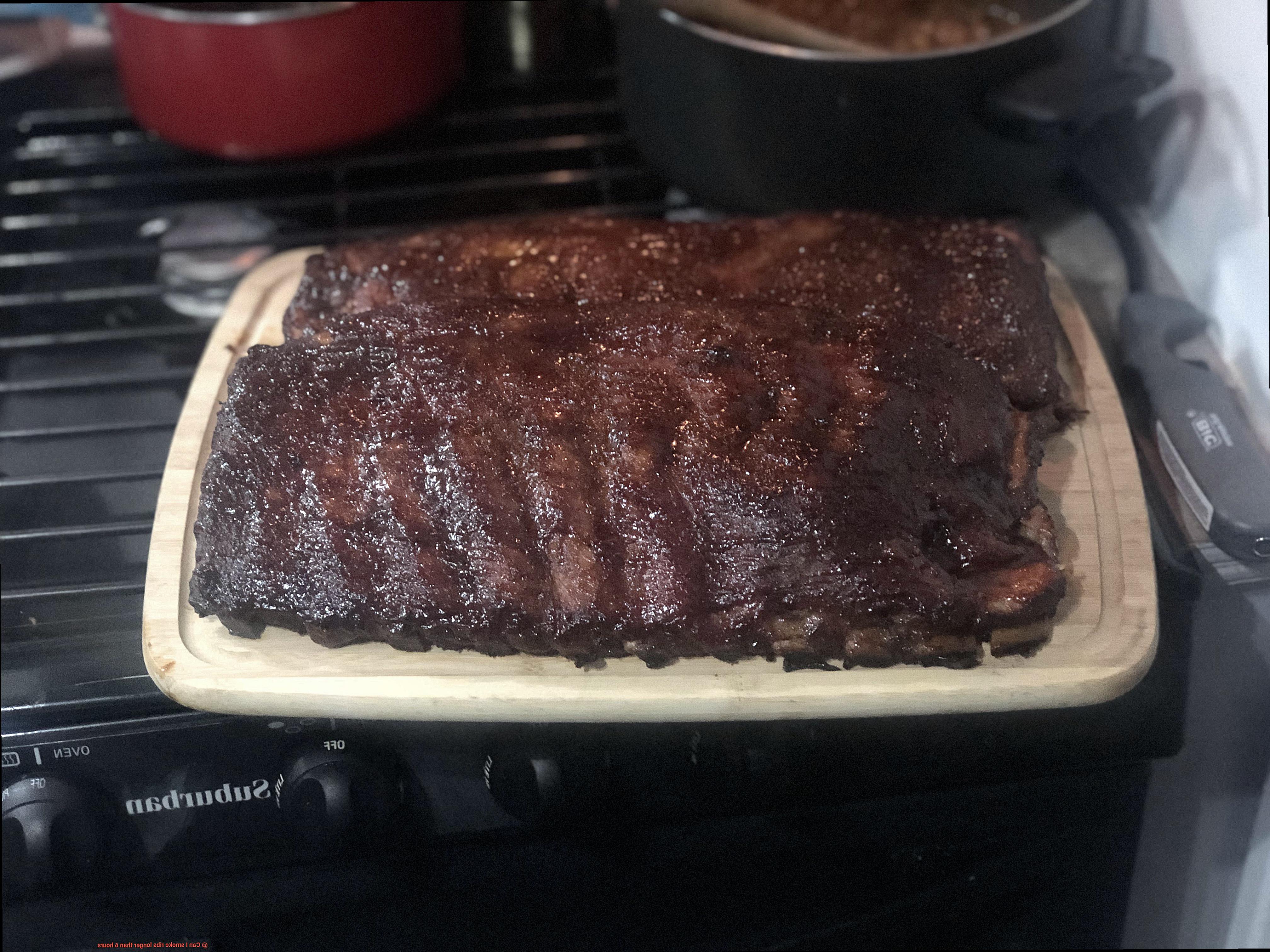
One of the critical factors in smoking ribs for an extended period is maintaining a consistent temperature. The ideal cooking time for smoking ribs varies based on the thickness of the meat, the type of smoker used, and the temperature. Generally, it takes around four to six hours to smoke a rack of ribs. However, some pitmasters prefer to smoke their ribs for longer periods, sometimes up to eight or ten hours.
The extended cooking time allows the meat to develop a deeper, more complex flavor. This is because the smoke can penetrate deeper into the meat, resulting in a more intense smoky flavor. However, smoking ribs for too long can cause them to become dry and tough. This occurs when the moisture in the meat evaporates due to the longer cooking time.
To avoid this outcome, it’s essential to monitor your meat closely and make adjustments as needed. This may involve wrapping your ribs in foil or butcher paper partway through the cooking process to help retain moisture. It may also involve adjusting the temperature and cooking time based on how the meat is responding.
Another critical factor in smoking ribs for an extended period is the type of smoker used. Electric smokers and pellet grills are known for their ability to maintain a consistent temperature, making them ideal for extended smoking sessions.
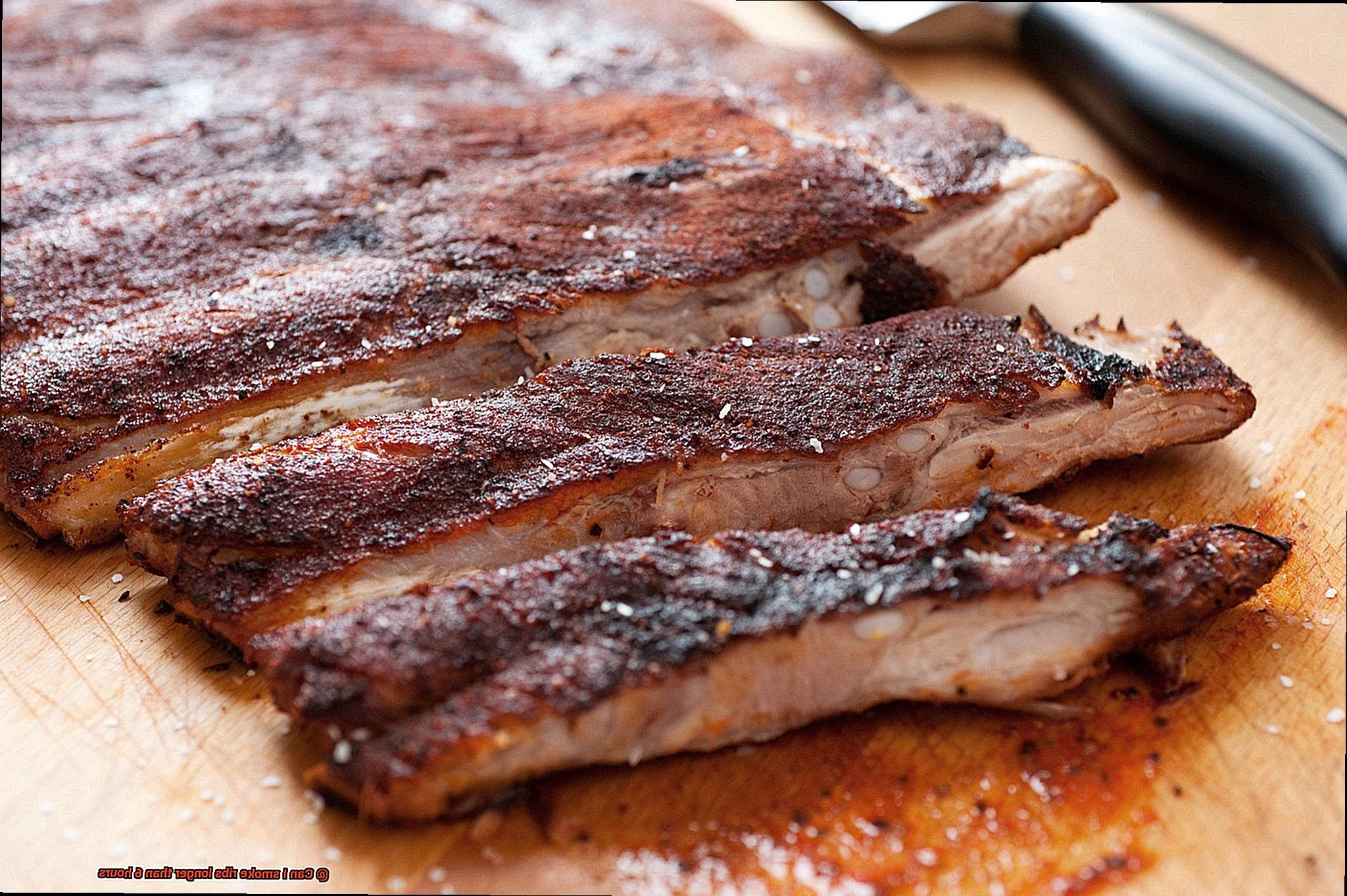
The type of wood used is also crucial in achieving a delicious end product. Hardwood such as hickory, oak, or mesquite provides a smoky flavor that complements the meat’s taste. However, using too much wood can overpower the meat’s flavor and even make it bitter.
It’s also essential to keep an eye on the internal temperature of the meat when smoking ribs for an extended period. The USDA recommends cooking pork ribs to an internal temperature of 145°F. However, some pitmasters prefer to cook their ribs until they reach an internal temperature of 190°F, which can take several hours.
Factors Affecting the Ideal Cooking Time for Smoking Ribs
Smoking ribs is more than just cooking meat; it’s an art form that requires attention to detail and patience. One of the critical aspects of achieving perfectly smoked ribs is determining the ideal cooking time, which can vary based on several factors. Let’s dive into the different factors that affect the ideal cooking time for smoking ribs.
Firstly, the type of ribs being used plays a crucial role in determining the cooking time. For example, baby back ribs typically require less time to cook than spare ribs due to their smaller size. Moreover, the thickness of the ribs can also affect cooking time. Thicker ribs require more time to cook through than thinner ones, making it essential to consider the specific cut of ribs being used.
Temperature is another crucial factor that affects the ideal cooking time for smoking ribs. A lower temperature will result in longer cooking times, while a higher temperature will result in shorter cooking times. Consistency is key here; it’s crucial to maintain a consistent temperature throughout the cooking process to ensure that the ribs are cooked evenly.
The type of smoker being used is also an essential factor in determining the ideal cooking time for smoking ribs. Different types of smokers have unique characteristics that can impact cooking times and temperature ranges. For instance, electric, charcoal, and gas smokers all have their specific quirks that need to be taken into account when determining the ideal cooking time.
The level of tenderness and flavor desired can also impact the ideal cooking time for smoking ribs. Some people prefer their ribs to be fall-off-the-bone tender, while others like a bit more texture. The level of seasoning and marinade used can also affect the overall flavor of the ribs and may require adjustments to the cooking time.
Benefits of Smoking Ribs for Longer Periods of Time

If you’re a fan of mouth-watering, fall-off-the-bone ribs, then smoking them for longer periods of time is the way to go. As an expert on the subject, I can attest that it’s well worth the added effort and time. Here are some of the benefits of smoking ribs for longer periods of time:
- Deeper Smoke Penetration: The longer your ribs are exposed to smoke, the deeper the flavor will penetrate into the meat. This results in a more pronounced smoky flavor profile that is sure to satisfy your taste buds.
- Tender and Juicy Meat: Smoking ribs for longer breaks down the connective tissue in the meat, making it more tender and juicy. Each bite will be a melt-in-your-mouth experience that will leave you wanting more.
- More Pronounced Smoke Ring: The smoke ring is a pink ring that forms around the meat during the smoking process. It’s not only visually appealing but also adds another layer of smoky flavor to your ribs.
- Experimentation with Different Wood Types and Flavors: By extending your smoking time, you have more opportunities to try out different wood types and flavors. From hickory to mesquite to fruitwood, there are endless possibilities to create unique flavor profiles that suit your taste preferences.
However, it’s essential to keep an eye on the cooking process during extended smoking times. Overcooking can dry out your meat and make it tough, which is something you want to avoid at all costs. To prevent this, use a meat thermometer to monitor the temperature and wrap your ribs in foil or butcher paper to retain moisture.
Potential Pitfalls of Smoking Ribs for Too Long
Smoking ribs is an art form that requires attention to detail and patience. As a pitmaster, you know that the general rule of thumb for smoking ribs is 4-6 hours. But maybe you want to experiment with different wood types and flavors and smoke your ribs for longer. However, be aware that smoking your ribs for too long can lead to potential pitfalls that can ruin the taste, texture, and appearance of your meat.
One of the main risks of smoking ribs for too long is overcooking. Overcooking can cause the meat to become dry and tough, making it difficult to chew and swallow. This is especially true for leaner cuts of meat, such as baby back ribs, which have less fat content and are more prone to drying out. So, keep an eye on the cooking time and internal temperature using a thermometer to ensure that your ribs are cooked to perfection without overcooking.
Another potential pitfall of extended smoking times is an excessively smoky flavor. While some people may enjoy a strong smoky taste, others may find it overpowering and unpleasant. Too much smoke can also mask the natural flavor of the meat, making it difficult to appreciate the seasoning and rub that you worked so hard on. Therefore, keep the smoke level in check and adjust your smoking time accordingly to achieve a balanced flavor without over-smoking your ribs.
In addition to these issues, smoking your ribs for too long can also impact the appearance of the meat. Extended smoking times can cause the ribs’ exterior to become overly dark and charred, giving them a burnt appearance that may not be appetizing to everyone. Remember that we eat with our eyes first, so it’s essential to keep visual appeal in mind.
To avoid these potential pitfalls, it’s crucial to monitor the temperature and smoking time carefully. Use a thermometer to check the internal temperature of the meat regularly, and adjust your cooking time accordingly. Additionally, be mindful of the smoke level and adjust your smoking time to achieve a balanced flavor without over-smoking your ribs.
Tips for Avoiding Overcooking and Drying Out the Ribs
Smoking ribs is a labor of love, but it’s all worth it when you bite into juicy, flavorful meat. However, one false move can lead to overcooked and dry ribs. To avoid this pitfall, you need to pay close attention to the temperature of your smoker and the internal temperature of the meat. Here are five tips for avoiding overcooking and drying out your ribs:
Monitor the temperature of the smoker
The ideal temperature for smoking ribs is between 225-250 degrees Fahrenheit. If the temperature drops too low, the meat will take longer to cook, leading to dry and tough ribs. On the other hand, if the temperature is too high, the ribs may cook too quickly and become overdone. Invest in a good quality thermometer to ensure that you maintain a consistent temperature throughout the entire smoking process.
Use a meat thermometer
While it’s important to monitor the smoker’s temperature, it’s equally important to keep an eye on the internal temperature of the meat. The USDA recommends cooking pork to a minimum internal temperature of 145°F, while beef should be cooked to at least 145°F for medium-rare or 160°F for medium. Using a meat thermometer will help you avoid overcooking or undercooking your ribs.
Wrap your ribs
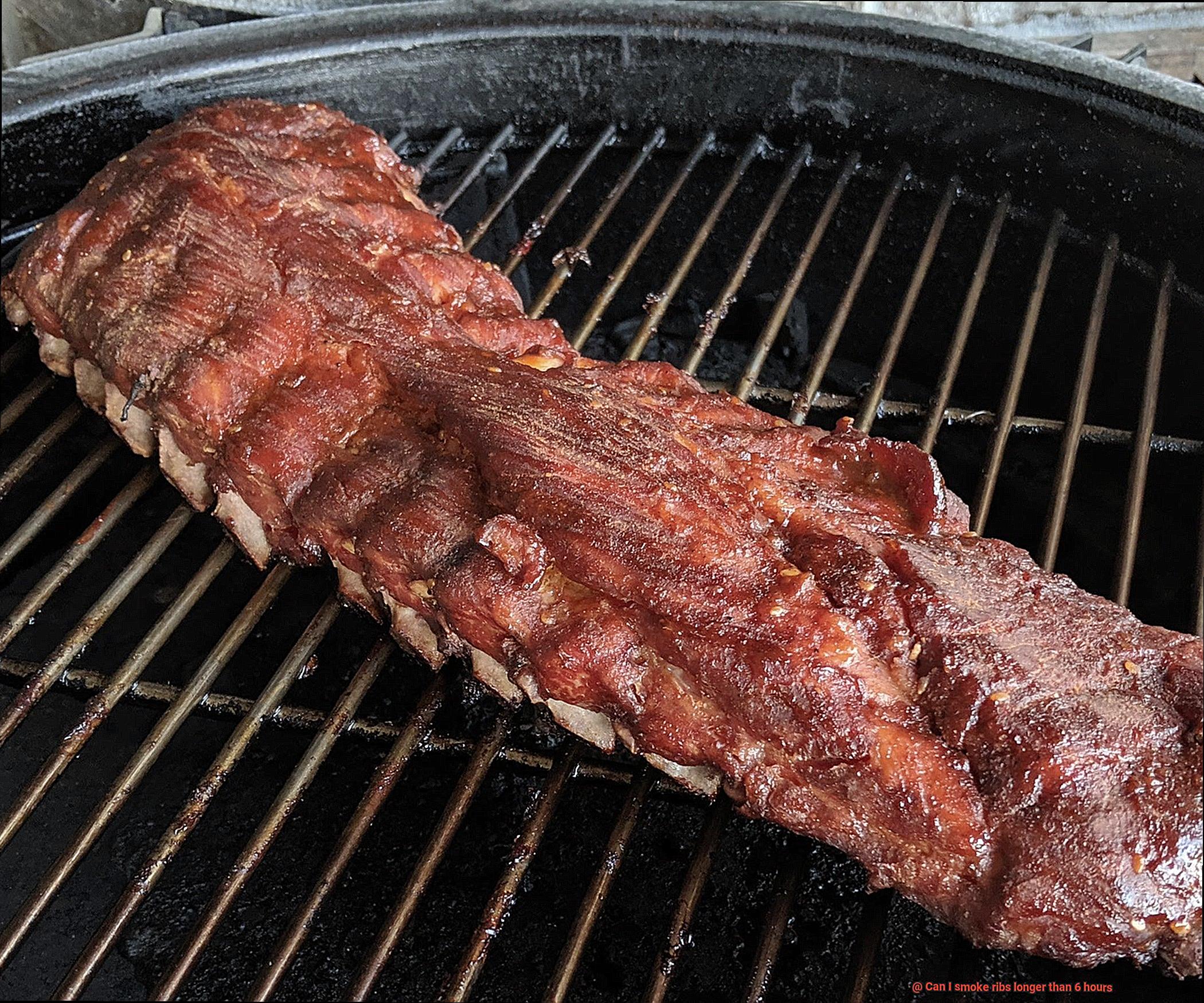
Wrapping your ribs in foil or butcher paper during the smoking process helps to retain moisture and prevent them from drying out. This technique, known as “the Texas crutch,” is especially helpful after a few hours of smoking.
Avoid peeking
Every time you open the smoker, you let out heat and smoke, which can prolong cooking time and lead to dry ribs. Trust your thermometer and only check on your ribs when necessary.
Use a mop or spray bottle
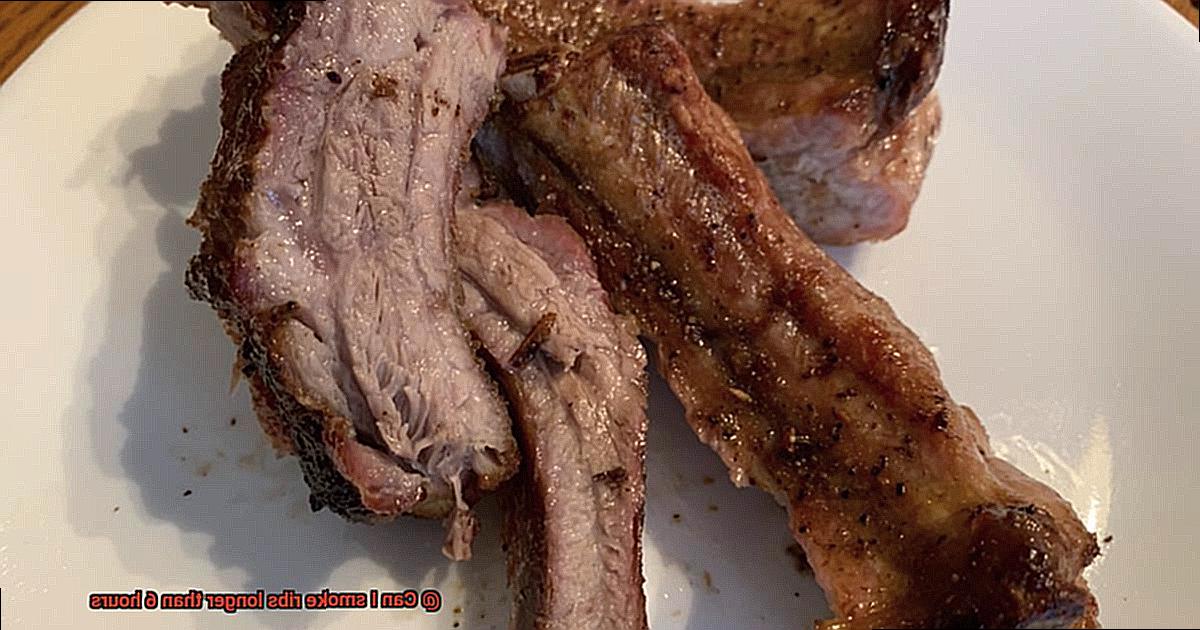
Using a mop or spray bottle filled with apple cider vinegar or apple juice can help keep your ribs moist during smoking. Lightly misting the meat every hour or so will help prevent dryness and add flavor.

Adjusting Temperature and Cooking Time Based on Meat Responses
Smoking ribs is a culinary art that can take hours of patience and precision to perfect. The key to achieving lip-smacking ribs lies in adjusting the temperature and cooking time based on the meat’s response. Here, we will delve into the details of how to adjust temperature and cooking time when smoking ribs for an extended period.
Firstly, it’s important to dispel the myth that smoking ribs for more than six hours is a bad thing. In reality, smoking ribs for eight to ten hours or even longer can result in a more tender and flavorful outcome. However, several factors must be taken into account when smoking ribs for an extended period.
To ensure that your smoked ribs are safe to consume, it’s essential to monitor the internal temperature of the meat using a meat thermometer. The USDA recommends cooking pork to an internal temperature of 145°F, which should be achieved within four hours of cooking. However, when smoking ribs, you can cook them at a lower temperature (around 225°F) for a more extended period without compromising their safety.
Cooking time varies depending on several factors such as the thickness of the meat, the type of smoker used, and the desired level of doneness. Aim for an internal temperature of around 195°F for fully cooked and tender ribs. However, it may take anywhere from six to ten hours or even longer depending on these variables.
Smoking ribs for too long can result in dry and tough meat. To avoid this, try using the Texas Crutch method by wrapping the ribs in foil or butcher paper halfway through cooking. This technique helps retain moisture and create a more tender outcome.
Wrapping the Ribs in Foil or Butcher Paper to Retain Moisture
Smoking ribs is a time-honored tradition that requires patience, skill, and a keen eye for detail. One of the most critical aspects of smoking ribs is keeping them moist throughout the cooking process. Wrapping your ribs in foil or butcher paper is a popular technique used by grillers to achieve this goal.
By wrapping your ribs, you create a barrier that traps moisture inside the meat, preventing it from drying out during longer cook times. The longer the cooking time, the more important it becomes to keep your meat moist. Wrapping your ribs can help ensure that the end result is juicy and perfectly cooked.
When it comes to choosing between foil and butcher paper, there are some key differences to consider. Foil creates a tight seal that prevents steam and moisture from escaping, which can be beneficial for maintaining moisture in your meat. Butcher paper, on the other hand, allows for some steam to escape while still retaining moisture in the meat.
However, it’s essential to note that wrapping your ribs can also affect their texture and flavor. Wrapping can make your ribs more tender and fall off the bone easily, but it may also cause them to lose some of their smoky flavor. Ultimately, the decision to wrap your ribs will depend on your personal preference.
Experimentation is Key to Discovering the Perfect Cooking Time
When it comes to smoking ribs, there’s no denying that experimentation is the key to discovering the perfect cooking time. Every smoker is unique, and so is every rack of ribs. There are several factors that can impact the cooking time, such as the type of smoker you’re using, the size and thickness of your ribs, the temperature at which you smoke them, and even the type of wood you use.
Your smoker’s type is a significant consideration when smoking your ribs. An electric smoker may have different cooking times than a charcoal smoker. The size and thickness of your ribs are also critical factors as they can affect the cooking time.
The temperature at which you smoke your ribs is equally important. It’s generally recommended that you smoke your ribs at a temperature range of 225-250°F. However, some smokers may have hot spots or fluctuating temperatures that can impact the cooking time.
In addition, the type of wood used for smoking can significantly affect both the cooking time and flavor of your ribs. Different woods have varying burn rates, produce different levels of smoke, and could potentially impact the cooking time of your ribs.
The only way to determine the perfect cooking time for your ribs is through experimentation. Begin by smoking your ribs for six hours at 225-250°F, then check them for doneness. If they’re not tender enough, continue smoking them in 30-minute increments until they reach your desired level of tenderness.
Keeping notes on each smoking session is crucial when refining your technique over time and achieving consistent results with each batch of ribs you smoke. Record the temperature, wood used, and cooking time for each session. Remember, practice makes perfect.
FZx54t9F3PA” >
Conclusion
In summary, smoking ribs beyond the six-hour mark is not only doable but can also produce a delectable, succulent, and flavorful meat that’s worth the extra time. Nevertheless, there are several critical factors to bear in mind when smoking ribs for longer periods.
One such factor is maintaining a consistent temperature throughout the cooking process. You should also keep an eye on the internal temperature of the meat using a thermometer to ensure it’s cooked to perfection. To retain moisture and prevent your ribs from drying out during extended cook times, consider wrapping them in foil or butcher paper.
It’s essential to experiment with different cooking times to discover what works best for your smoker and rib size. The type of smoker you use, the thickness of your ribs, the smoking temperature, and even the wood you use can all impact cooking time and flavor.
To avoid overcooking or drying out your ribs, adjust the temperature and cooking time based on how the meat responds. Additionally, using a mop or spray bottle filled with apple cider vinegar or apple juice can help keep your ribs moist while smoking.
Smoking ribs requires patience and skill, but with practice comes perfection.


